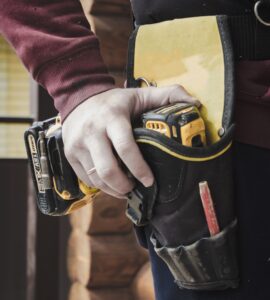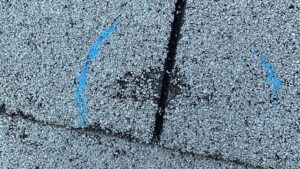Hail is incredibly damaging to roofs. The smallest pea to penny-sized hail damages the roof’s surface and makes it less weather-resistant. Hail that’s quarter-sized or around 1” in diameter has enough of an impact to cause immediate damage.
Hailstorms are becoming more frequent and severe, leaving homeowners with significant repair projects. Fortunately for most, a standard homeowners’ insurance policy does cover hail damage.
Does homeowners’ insurance cover hail damage?
Yes, but it depends. Homeowners’ insurance typically includes hail as a covered peril since it’s an unforeseen and unavoidable event that damages the roofing structure and compromises the home.
For most people, getting homeowners’ insurance to cover hail damage is as simple as contacting them and letting them know what happened. The insurance company will send an adjuster out to evaluate the damage and determine what should be covered.
However, there are cases when insurance companies won’t cover hail damage.
When doesn’t homeowners’ insurance cover hail damage?
Insurance companies love finding reasons to not pay up… to avoid covering losses…get out of paying homeowners. And that’s true for hail damage as well.
There are three main conditions under which homeowners’ insurance won’t cover hail roofing damage.
- The damage is only cosmetic.
- Hail or windstorms happen frequently.
- The roof is fairly new.
Aside from these three conditions, insurance companies may deny coverage for roofs that haven’t been properly maintained.
What is a Cosmetic Damage Exclusion?
A cosmetic damage exclusion means insurers won’t cover hail damage that only impacts the roof’s appearance. Their reasoning is that property insurance is to cover physical structure damage – and not its economic value.
Cosmetic exclusions can be restricted to the roof itself while other areas of the house are covered.
It can be difficult to distinguish cosmetic from functional hail damage. If you have questions or doubt what the insurance company says, ask an experienced roofer for a thorough inspection.
Homes in hail-prone areas might not be covered
Insurance companies don’t always cover hail damage for homes located in areas that are prone to windstorms, hailstorms, tornadoes, or hurricanes.
Homeowners’ insurance policies in these places may have a hail exclusion, restricted coverage, or higher deductibles.
If you live in a place where hail or windstorms are common, review your policy for exclusions, restrictions, or wind and hail deductions.
Hail damage to newer roofs might not be covered.
Insurance companies aren’t always willing to cover minor hail damage to a newer roof. That’s because a newer roof is expected to be more durable and weather-resistant than an older roof that’s already been prone to wear and tear.
If this happens, it can be helpful to contact an experienced roofing contractor for advice and an independent inspection.
Hail damage coverage may be restricted to repairing or replacing the damaged area
Is the hail damage restricted to a certain area? The insurance company might only offer a partial roof replacement.
This is another case where it’s good to consult with a qualified roofing contractor, instead of just relying on the insurance company’s adjustor-based assessment.
Does homeowners’ insurance cover the full costs of a roof replacement?
Not necessarily. Your deductible will be subtracted from the coverage amount. If the deductible is high or the damage only requires a partial repair, the policy might not cover anything.
Insurance for homes in hail-prone areas might have a separate wind and hail deductible. These extra deductibles are often set at a percent of the homeowners’ insurance. For example, a 3% wind and hail deductible on a home insured for $300,000 would require homeowners to first cover $9,000 of hail-related roof damage.
How to file a roof insurance hail damage claim
The general process for filing a hail damage claim is to contact the insurance company, meet with an adjuster, and get a professional roofer to repair or replace the roof.
Here’s an outline of what to do:
- Confirm if the roof has hail damage before filing a claim. Ask a professional roofer to inspect the roof and document the damage. You can do this yourself if you understand what hail damage looks like and feel comfortable inspecting the roof.
- Verify that hail damage is covered under your homeowners’ insurance policy. Claims for non-covered damages are added to your claims history, so it’s a good idea to double-check before filing.
- File a claim with your homeowners’ insurance provider, including as much documentation as possible.
- Meet with the insurance adjuster. The adjuster will inspect the roof and determine the coverage level.
- Receive the settlement and have a professional, licensed roofer complete the repairs.
Is the roof leaking, badly damaged, or structurally compromised? Situations like this require immediate repairs and it may not be possible to wait for a claim to go through. If this is the case, contact a licensed roofer who offers emergency services.
Follow these steps:
- Have a professional roofer inspect the roof, document it, and recommend the next steps.
- File a claim with your homeowners’ insurance provider and inform them that the roof needs emergency repairs. Provide them with pictures, footage, and other documentation.
- Have the roofer make an emergency repair.
- Meet with the insurance adjuster.
- Receive the settlement and bring the roofer back to do permanent repairs.
The two most important things to do are to contact your homeowners’ insurance and find a reliable, licensed roofer to work with. An experienced roofing contractor will thoroughly evaluate the damage and make sure the insurance provider knows how bad things are.
Always get a second opinion if the adjuster’s assessment results and recommendations aren’t what you expected.
Hail Damage Roofing Repair
Hail damage has to be repaired immediately, whether it’s light or severe. Even small hailstones can compromise a roof’s weather resistance and make it more susceptible to future storms.
If there was a recent hailstorm in your area, contact a roofing contractor for an inspection. The roofers should inspect the full roofing structure – including shingles, flashing, fascia, and gutters. Plus, they can take a look at your siding and make sure it’s in good shape too.
Message the hail claim experts at Midwest Roof & Solar if you need roofing services in Minneapolis or the Twin Cities area. We’ve provided local homeowners with quality, hassle-free roofing work for over 20 years. Our services include roofing inspections, emergency repairs, and structural work. And you can always reach out to get pro tips on dealing with your homeowners’ insurance provider.





